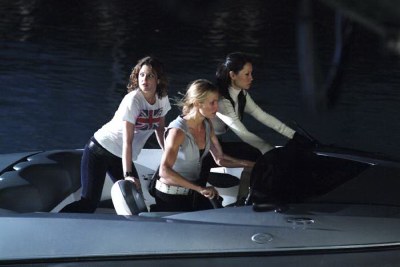cameron diaz movies
|
|
 Chapter 11 - The Locations
With the exception of the Charles Townsend Agency, the film rarely ventures to the same location twice. The Angels are in constant motion. Location manager Kenneth D. Lavet drove hundreds of miles throughout the Los Angeles area to find the thirty or so diverse locations McG envisioned for the film. "McG likes the idea of celebrating Los Angeles, so there are a lot of iconic landmark locations in the film," explains Lavet. "He has an encyclopedic memory and knew of the best pop locations in the city."
"One of our mantras," says McG "is that Charlie's Angels has been designed as a love letter to the city of Los Angeles. Every location had to matter. Everything had to be a landmark, to have historical significance. While there have been several films that were paeans to the legacy of New York City, Los Angeles is often seen as a more disposable city. But in our film you won't see any mini-malls. You'll see a more hidden L.A., amazing locales like the ornate Los Angeles Theatre, brilliant John Lautner-designed homes, extraordinary beaches that exist only on the west coast of North America, the docks of San Pedro and the Griffith Park Observatory, to name but a few."
Timing played a big part in what locations were available. Sometimes, Lavet says, the production got lucky. "Normally you can only shoot at the Griffith Park Observatory one day a week when the facility is closed to the public. Because it was about to undergo a massive renovation, we were able to slip
in there and shoot for over a week." McG had always wanted to use the landmark, but never before had it been available at the right time. "I'm very influenced by Rebel Without a Cause, which was shot up there. Plus, it has an architectural quality that allows you to look at it in a big, wide shot and it's very bold. It also has an 'angelic' quality in that it looks over the City of Angels."
The Observatory is also a dramatically significant icon and the location in which the character of Madison Lee is finally revealed. "When I learned that the top piece of the Observatory telescope rotunda would rotate, I knew that I wanted to place her up there," says McG. "We had to build a special rig to keep Demi from falling because as it goes around it jerks and could have bucked her out. I love the reveal when Natalie and Alex get a look at Madison and realize she's betraying the Angels ethos. It's a powerful scene."
Another difficult location was the house in which Liu's character resides, which is perched on a promontory overlooking Beverly Hills with views of the Pacific Ocean and Catalina Island. The Sheets-Goldstein residence is a true architectural landmark and one of McG's favorite L.A. houses. "It's a perfect synthesis of the city's indoor-outdoor living experience, sort of the crowning achievement of architect John Lautner's career," McG smiles.
For the motocross sequence, explains Lavet, "McG wanted the event to be more of an illicit motorcycle race than one held in a stadium. He wanted a covert event where riders pay a fee and winner takes all."
"I wanted to create a stark, dangerous backdrop," says McG. "We found an old coalfield in San Pedro and cleared out all the coal, creating a 360-degree stadium made of coal. All you get is the composition of blue sky, black coal and then these almost animatronic athletes a hundred feet in the air doing flips and pop wheelies. It was just the sort of emotion I wanted to feel the speed, the danger, the sexiness and excitement that are embodied in the sport."
Another San Pedro location was the nearby Southwest Marine dockside. "The largest harbor in the Los Angeles area is in San Pedro and we took advantage of the giant tanker ships and the idea that the O'Grady clan's secret hideout was aboard one of these hollowed-out super-tankers," says McG. "It also gave me the opportunity to get the girls into some welding outfits and take advantage of that Flashdance imagery of beautiful girls ripping off welding masks."
Another landmark used in the film was the Hansen Dam in the San Fernando Valley. The 62-year-old structure, which operates under the auspices of the Army Corps of Engineers, is usually used for flood control. Through the digital magic of computer simulation and the sawdust hammer-and-nails work of scores of propmakers, the 10,475-foot-long dam was transformed into an eerie Mongolian border crossing. Faux lookout towers and a disposable plaster-and-wood wall with a huge door added to the exotic aura. Set atop the dam was a 49-ton M60 A-1 (Patton) tank that was rented from the American Society of Military History and Museums.
"That scene was a real achievement for the art department," recalls Riva,"because McG kept talking about the opening of the picture and how it had to be huge and overpowering. We designed and animated a sequence based on his pitch, and it was that sequence that got everyone at the studio excited. We eventually shot it on film. At first we thought we might have to build this giant dam that's supposed to be in Mongolia. But working in conjunction with our visual effects supervisor Mark Stetson, we created something out of a Los Angeles location that, with a little effects magic, felt like Mongolia. We even had snow and sand on the ground and extras dressed up in giant yak parkas in the 95-degree heat. But it worked."
|